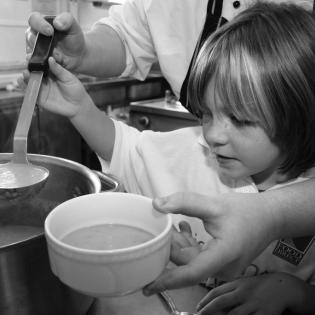Harvesting the Produce
In this lesson, we explore where vegetables come from and how they are preserved for healthy eating.
The learner will:
- describe how vegetables are grown and harvested.
- identify a variety of vegetables as healthy choices.
- food dehydrator
- variety of vegetables donated by participants, if appropriate
- read-aloud copy of Growing Vegetable Soup (see Bibliography)
- journals
The day before this lesson, ask children to bring a single fresh vegetable to the group meeting and a written description of how they got it. They may bring any fresh vegetable that can contribute to a soup mix they will donate in the final session. Note: Any cans that are brought in may be donated, but they won't add to the soup mix. Be sure to acknowledge the generosity of each donation.
philanthropy: giving time, talent, or treasure and taking action for the common good
Before this session, send a note home to ask participants to bring in a vegetable to contribute to a soup. Along with their vegetable, they also bring in a written (or illustrated) account of the process of obtaining their vegetable, which may be as simple as finding it in the refrigerator or as detailed as growing a garden over the summer.
Ehlert, Lois. Growing Vegetable Soup. New York: Harcourt, 1987. ISBN: 0152325751.
Instructions
Anticipatory Set:
As you come together, have participants record a yes-or-no response on a graph to the question of the day: Did you bring a carrot to school today? or Did your vegetable come from a garden?
Discuss the data collected on the simple graph.
Variation: Make a "real graph" on a floor graph. Ask the children to name the types of vegetables they brought in. Write each vegetable on an index card to label the rows of the graph. Have them place their actual vegetables on the squares of the graph. Discuss the numbers and compare the amounts of each type of vegetable. Discuss how the graph helped you compare the numbers.
Discuss how the vegetables the students brought in were obtained.
- Invite them to tell their own experiences with gardening and harvesting food from a garden. If their family purchased vegetables, ask students to propose how the vegetables got to the store.
- Tell the children that eventually they are going to be making some dried soup mix that they will share with people in the community. Thank them for the generosity in sharing their produce. Introduce the meaning of the word, philanthropy.
Since the soup will be used much later, the vegetables need to be preserved. Discuss the different ways that food can be preserved: frozen, canned, or dried. Discuss the importance of keeping the food and your hands clean while preparing the food. (It would be helpful to have a parent available to cut the vegetables. The slices should be uniform in size.)
- Teach the meaning of the word dehydrate. Explain that the dehydrators take the water out. Ask children to predict how long they think that might take. Record their predictions on a calendar.
- If you allow the children to place the vegetable pieces on the dehydrator trays, it is very important that their hands are clean.
- Note: As you check the vegetables each day, refer to the predictions. Use the calendar to monitor predictions as they correspond to actual dates.
Read Growing Vegetable Soup. Discuss the process of planting and growing vegetables. Help the children read and identify the different garden-related items in the pictures. Encourage them to listen respectfully to each other's stories about garden experiences. Talking about the art style may inspire art in the optional center activity.
Optional: Children work individually or in groups in the following center activities: ART: Paint pictures of single vegetables. WRITING: In journals they draw a picture of a garden and then label/write about how vegetables grow. MATH: Practice number recognition, counting, and number sense by placing the corresponding number of vegetable pieces, seeds, or pictures on numeral cards. SNACK: Taste red, green and yellow peppers with vegetable dip. SCIENCE: Graph which type of pepper each child preferred. DRAMATIC PLAY: Provide props for students to pretend to harvest, buy and sell, and cook vegetables.
Write/illustrate observations in science journals over the course of the drying period. Have them include three things in their journals each day: date the page, draw a picture of the same piece of vegetable, and write about what it looks like or how it has changed.
Philanthropy Framework
-
Strand PHIL.I Definitions of Philanthropy
-
Standard DP 01. Define Philanthropy
-
Benchmark E.1 Define philanthropy as the giving and sharing of time, talent, or treasure intended for the common good.
-
-
